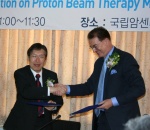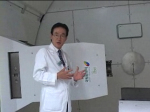Korea promotes medical tourism to attract proton therapy patients
July 15, 2010
by Barbara Kram, Editor
South Korea wants to become a "radiation vacation" destination.
American prostate cancer patients sometimes joke that their course of treatment at U.S. proton therapy centers like Loma Linda, California or Jacksonville, Florida is like taking a "radiation vacation." Patients undergo eight weeks of brief daily treatments and typically feel no ill effects, allowing plenty of time for golf and relaxation.
Now the government of South Korea wants a piece of the action and invited DOTmed News and other media outlets and organizations to Seoul to get the word out about the proton therapy center within Korea's National Cancer Center. A press event was held July 8 for the signing of a memorandum of understanding by NCC President Dr. Jin Soo Lee and Charm Lee, president of the Korea Tourism Organization. The MOU is similar to a proclamation lauding the proton program and stating the intent to promote Korea's medical offerings.
"Korea is on the forefront of medical technology and the level of technical skill of our doctors and facilities is top of the world. Korea's time as a tourism destination is coming and people are starting to realize that Korea has a lot to offer and is not a third world country," said Charm Lee. "Patients spend two months for treatment and have an interesting, inspiring, refreshing, and regenerating experience," Lee said of proton treatment in Korea.
According to research firm RNCOS, South Korea received 25,000 foreign patients in 2008, an increase of 56 percent from 16,000 in 2007. The country received a large number of international patients from China, Japan and the Southeast Asian countries. More recently, according to Lee, medical tourism doubled from 2008 to 2009 in Korea mostly for cosmetic surgery and general checkups, which in Korea include a full-body MRI scan. Korea is now targeting patients with more serious conditions from North America, Europe, the Middle East, India, and Russia. The South Korean government is expected to continue its push to promote medical tourism. RNCOS projects the medical tourism market in South Korea will grow at a CAGR of around 30 percent from 2010-2012.
America Is a Target for Protons
NCC also hosted a forum of lectures focused on proton therapy and attended by about 75 hospital staff, students, guests and press from Korea, China, Japan, and the U.S. Speakers included clinicians, organization heads, and marketing people.
Korea believes that the U.S., with its high prevalence of prostate cancer (less common among Asian men), is a perfect fit for a package that costs a patient $48,000 and includes airfare, lodging, daily ground transportation to and from the hospital (about 40 minutes from the center of Seoul), and other perks. Treatment includes international coordination; consultation; treatment planning; production of the customized aperture and compensator, which target proton radiation to the specific tumor site; and proton beam therapy treatment, an advanced form of radiation therapy, available at just seven U.S. centers.
"If [patients are] fit for a long trip, they're usually fit for treatment because they don't get sick from this treatment," said radiation oncologist Dr. Kwan H. Cho. Dr. Cho, like many of the NCC staff had medical training in the U.S. as well as Korea. "There are a lot of patients in the United States. We have two [rotating] gantry rooms and they don't have to wait."
What type of patient will take Korea up on this offer?
"Probably a handful of prostate cancer patients, at first, will consider this a unique travel opportunity and a potentially enlightening experience to be treated in a foreign country for eight or nine weeks while limiting their out-of-pocket medical costs. They'll need to be confident their treatment will be handled by experienced proton physicians at a world-class proton center. They'll want to check all that out first. Then, it will be up to those early on patients to spread the positive word around," said Leonard Arzt, executive director of the National Association for Proton Therapy, one of the guests in Seoul. He noted, "Many times, because prostate patients have a number of options in the U.S., the choice of where to get proton therapy often comes down to lifestyle. Patients may go to a center near where a relative lives, to play golf, go to the beach, or use the time to work."
Korea is hoping that international travel (it can take 24 hours door-to-door from New York to Seoul) is a desirable element that will attract patients to the peninsula. The arrangement might have been the right fit for someone like Curtis Poling, who was too young for Medicare, when he was diagnosed with prostate cancer two years ago. Poling had successful treatment at Loma Linda University Medical Center but was left with a $160,000 tab and a fight with his insurance company. (Loma Linda declined to give DOTmed News the price range for their treatment.) Poling eventually won and got his insurance to cover it but he now works as an advisor for KMI, the Korean medical tourism marketing firm hired by KTO. He said he would have taken the Korea option if it had been available at the time.
"At 53, I knew I had to be treated sooner not later," said Poling, who also runs a window insulation firm in Georgia. "My health is great with no side effects and proton beam therapy was an excellent choice for me." But he spent $10,000 to live in California during treatment. "I had to stay away from home for over two months and was bored. I think Korea is an alluring site, especially with the generosity and hospitality of the Korean people. It's great for those seeking proton beam options for the un- or under-insured."
Korea Built It; But Will They Come?
South Korea has national health insurance that covers up to 70 percent of medical services, but proton beam therapy, which uses a three-story particle accelerator and moving gantries to precisely control radiation exposure, is not covered. Korea opened its National Cancer Center in the Ilsan district northwest of central Seoul in 2001 with the proton center completed in 2007. The proton facility, equipped by IBA of Belgium, includes two rotating gantries and one fixed beam room. An additional room is in the planning stages.
The National Cancer Institute estimates there will be nearly 218,000 new cases of prostate cancer in the U.S. in 2010 and more than 32,000 deaths. Korea is betting that U.S. proton centers are or soon will be at capacity and that they can pick up some spillover even as proton facilities are being added stateside. In addition to Loma Linda University Medical Center, the currently operational U.S. sites include the University of Florida, M.D. Anderson Cancer Center, University of Pennsylvania, Indiana University, Procure in Oklahoma City, and Massachusetts General Hospital. An eighth U.S. proton therapy center is scheduled to open at Hampton University in Virginia this year. Also as reported in DOTmed News, Scripps Health will soon break ground on a center in San Diego; and Procure is developing several sites.
But will U.S. patients take Korea up on their offer? NCC staff speak English and are well trained. But perhaps the clearest benefit of Korea's program is its immediacy. Using an online process at first, patients must email a referral and their medical records along with imaging studies and lab tests. NCC gets back to the patient in just two days to determine if treatment is appropriate; after that, arrangements can be immediate to meet with an NCC doctor in Korea. The entire planning and preparation process can be done within one week. (Note: The price of the package does not include any additional imaging studies ordered by doctors in Korea. However it may include an exploratory trip to Korea, the cost of which is deducted if treatment at NCC goes forward.)
"Patients who go to Korea are likely to be those without another recourse. A Medicare patient is not going to come here when they are already covered," noted NAPT's Arzt. "But certainly those whose coverage may be an issue for one reason or another might consider coming to Korea, especially if they want to be treated sooner rather than later, instead of going through the appeal process. Timing can also be a factor."
Ultimately, to be successful in its promotional campaign for medical tourists from the U.S., South Korea will need to demonstrate that it's a resort for patients, and not their last resort.
--
An online gateway for patient referral to Korea's NCC is available at:
www.protonkorea.com .
American prostate cancer patients sometimes joke that their course of treatment at U.S. proton therapy centers like Loma Linda, California or Jacksonville, Florida is like taking a "radiation vacation." Patients undergo eight weeks of brief daily treatments and typically feel no ill effects, allowing plenty of time for golf and relaxation.
Now the government of South Korea wants a piece of the action and invited DOTmed News and other media outlets and organizations to Seoul to get the word out about the proton therapy center within Korea's National Cancer Center. A press event was held July 8 for the signing of a memorandum of understanding by NCC President Dr. Jin Soo Lee and Charm Lee, president of the Korea Tourism Organization. The MOU is similar to a proclamation lauding the proton program and stating the intent to promote Korea's medical offerings.
"Korea is on the forefront of medical technology and the level of technical skill of our doctors and facilities is top of the world. Korea's time as a tourism destination is coming and people are starting to realize that Korea has a lot to offer and is not a third world country," said Charm Lee. "Patients spend two months for treatment and have an interesting, inspiring, refreshing, and regenerating experience," Lee said of proton treatment in Korea.
NCC President Dr. Jin Soo Lee (l)
and KTO President Charm Lee
are promoting Korea as a
medical tourism destination
and KTO President Charm Lee
are promoting Korea as a
medical tourism destination
According to research firm RNCOS, South Korea received 25,000 foreign patients in 2008, an increase of 56 percent from 16,000 in 2007. The country received a large number of international patients from China, Japan and the Southeast Asian countries. More recently, according to Lee, medical tourism doubled from 2008 to 2009 in Korea mostly for cosmetic surgery and general checkups, which in Korea include a full-body MRI scan. Korea is now targeting patients with more serious conditions from North America, Europe, the Middle East, India, and Russia. The South Korean government is expected to continue its push to promote medical tourism. RNCOS projects the medical tourism market in South Korea will grow at a CAGR of around 30 percent from 2010-2012.
America Is a Target for Protons
NCC also hosted a forum of lectures focused on proton therapy and attended by about 75 hospital staff, students, guests and press from Korea, China, Japan, and the U.S. Speakers included clinicians, organization heads, and marketing people.
Korea believes that the U.S., with its high prevalence of prostate cancer (less common among Asian men), is a perfect fit for a package that costs a patient $48,000 and includes airfare, lodging, daily ground transportation to and from the hospital (about 40 minutes from the center of Seoul), and other perks. Treatment includes international coordination; consultation; treatment planning; production of the customized aperture and compensator, which target proton radiation to the specific tumor site; and proton beam therapy treatment, an advanced form of radiation therapy, available at just seven U.S. centers.
"If [patients are] fit for a long trip, they're usually fit for treatment because they don't get sick from this treatment," said radiation oncologist Dr. Kwan H. Cho. Dr. Cho, like many of the NCC staff had medical training in the U.S. as well as Korea. "There are a lot of patients in the United States. We have two [rotating] gantry rooms and they don't have to wait."
What type of patient will take Korea up on this offer?
"Probably a handful of prostate cancer patients, at first, will consider this a unique travel opportunity and a potentially enlightening experience to be treated in a foreign country for eight or nine weeks while limiting their out-of-pocket medical costs. They'll need to be confident their treatment will be handled by experienced proton physicians at a world-class proton center. They'll want to check all that out first. Then, it will be up to those early on patients to spread the positive word around," said Leonard Arzt, executive director of the National Association for Proton Therapy, one of the guests in Seoul. He noted, "Many times, because prostate patients have a number of options in the U.S., the choice of where to get proton therapy often comes down to lifestyle. Patients may go to a center near where a relative lives, to play golf, go to the beach, or use the time to work."
Korea is hoping that international travel (it can take 24 hours door-to-door from New York to Seoul) is a desirable element that will attract patients to the peninsula. The arrangement might have been the right fit for someone like Curtis Poling, who was too young for Medicare, when he was diagnosed with prostate cancer two years ago. Poling had successful treatment at Loma Linda University Medical Center but was left with a $160,000 tab and a fight with his insurance company. (Loma Linda declined to give DOTmed News the price range for their treatment.) Poling eventually won and got his insurance to cover it but he now works as an advisor for KMI, the Korean medical tourism marketing firm hired by KTO. He said he would have taken the Korea option if it had been available at the time.
"At 53, I knew I had to be treated sooner not later," said Poling, who also runs a window insulation firm in Georgia. "My health is great with no side effects and proton beam therapy was an excellent choice for me." But he spent $10,000 to live in California during treatment. "I had to stay away from home for over two months and was bored. I think Korea is an alluring site, especially with the generosity and hospitality of the Korean people. It's great for those seeking proton beam options for the un- or under-insured."
Curtis Poling, a prostate cancer patient
who is too young for Medicare
thinks Korea is a good option
for patients who have to pay
out of pocket for proton therapy
who is too young for Medicare
thinks Korea is a good option
for patients who have to pay
out of pocket for proton therapy
Korea Built It; But Will They Come?
South Korea has national health insurance that covers up to 70 percent of medical services, but proton beam therapy, which uses a three-story particle accelerator and moving gantries to precisely control radiation exposure, is not covered. Korea opened its National Cancer Center in the Ilsan district northwest of central Seoul in 2001 with the proton center completed in 2007. The proton facility, equipped by IBA of Belgium, includes two rotating gantries and one fixed beam room. An additional room is in the planning stages.
The National Cancer Institute estimates there will be nearly 218,000 new cases of prostate cancer in the U.S. in 2010 and more than 32,000 deaths. Korea is betting that U.S. proton centers are or soon will be at capacity and that they can pick up some spillover even as proton facilities are being added stateside. In addition to Loma Linda University Medical Center, the currently operational U.S. sites include the University of Florida, M.D. Anderson Cancer Center, University of Pennsylvania, Indiana University, Procure in Oklahoma City, and Massachusetts General Hospital. An eighth U.S. proton therapy center is scheduled to open at Hampton University in Virginia this year. Also as reported in DOTmed News, Scripps Health will soon break ground on a center in San Diego; and Procure is developing several sites.
But will U.S. patients take Korea up on their offer? NCC staff speak English and are well trained. But perhaps the clearest benefit of Korea's program is its immediacy. Using an online process at first, patients must email a referral and their medical records along with imaging studies and lab tests. NCC gets back to the patient in just two days to determine if treatment is appropriate; after that, arrangements can be immediate to meet with an NCC doctor in Korea. The entire planning and preparation process can be done within one week. (Note: The price of the package does not include any additional imaging studies ordered by doctors in Korea. However it may include an exploratory trip to Korea, the cost of which is deducted if treatment at NCC goes forward.)
"Patients who go to Korea are likely to be those without another recourse. A Medicare patient is not going to come here when they are already covered," noted NAPT's Arzt. "But certainly those whose coverage may be an issue for one reason or another might consider coming to Korea, especially if they want to be treated sooner rather than later, instead of going through the appeal process. Timing can also be a factor."
Ultimately, to be successful in its promotional campaign for medical tourists from the U.S., South Korea will need to demonstrate that it's a resort for patients, and not their last resort.
--
An online gateway for patient referral to Korea's NCC is available at:
www.protonkorea.com .




